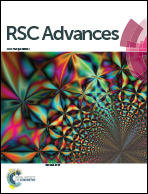Freestanding Cu nanowire arrays on Ti/Cr/Si substrate as tough nonenzymatic glucose sensors
Abstract
Exploring a tough, reusable and reproducible nonenzymatic sensor for glucose detection is required. Cu nanowire array electrodes on a Ti/Cr/Si substrate are prepared from an anodic aluminum oxide template film covered Ti/Cr/Si substrate by an electrodeposition method. The scanning electron microscope results indicate that Cu nanowires with a diameter of 50 nm and a length of hundreds of nm freestanding on the Ti/Cr/Si substrate are obtained. Electrochemical measurements indicate the freestanding nanowire array electrodes showing sensitivity of 1067 μA mM−1 cm−2 and detection limit of 1.87 μM when using the arrays as glucose sensors. The most attractive characteristics of the electrodes are the outstanding reusability and reproducibility, realizing a 1.77% relative standard deviation (RSD) of one electrode in five time tests and a 3.33% RSD of five electrodes for one sample. The application of the electrodes on determining the glucose concentration in human serum samples indicates the array electrode is a promising candidate as a practical sensor.


 Please wait while we load your content...
Please wait while we load your content...